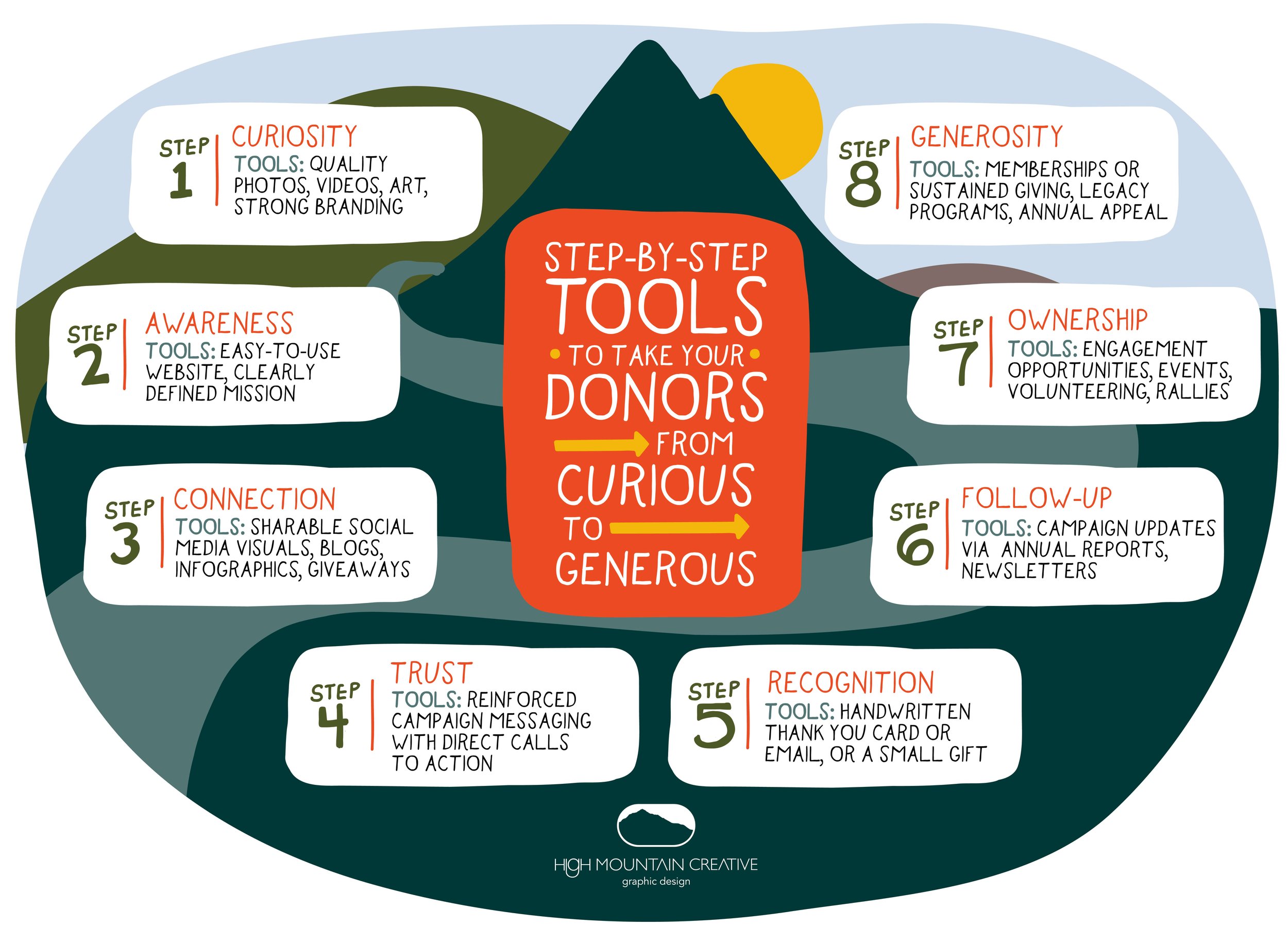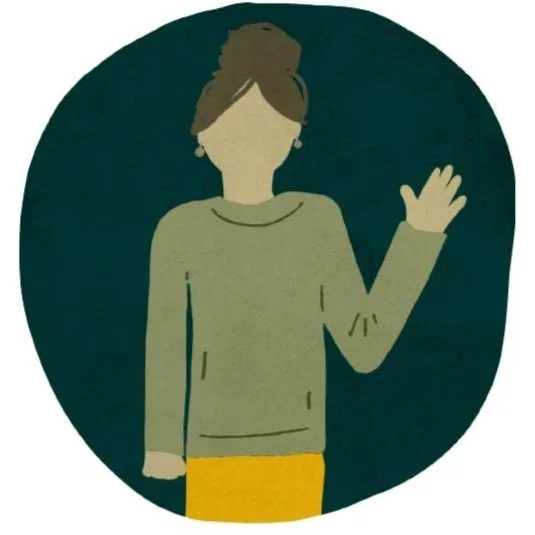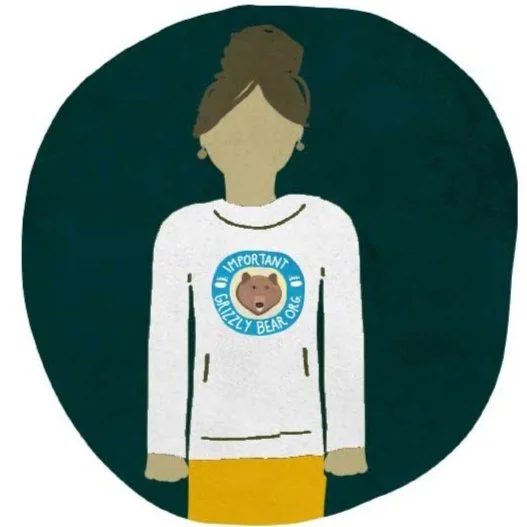A Donor’s Journey: Step-by-Step Tools to take your Nonprofit Donors from Curious to Generous
As anyone who has been tasked with fundraising knows, attracting and retaining loyal, consistent supporters is a challenging endeavor. It’s often a long game that requires persistence, patience and a true understanding of what makes a donor feel connected to your cause. I invite you to use the steps below as a starting point to consider with your audience at each stage of their journey in supporting your nonprofit. Follow along while I take you on a journey from stranger to life-long supporter.
Step 1: Curiosity
Meet Alice, Alice woke up this morning not even knowing your grizzly bear conservation organization exists. And so the journey begins. Maybe she discovers your cause at a community event, on a poster at the gym, or sees a friend share your post on social. Using compelling visuals like photos, videos or art and illustration piques Alice’s interest and plays a vital role in forming the initial emotional connection. Using strong and clear branding reinforces your organization's identity and fosters trust and recognition at these important early stages. Tools: unique-to-you quality photos, videos or art, strong branding
Step 2: Awareness
So, Alice has snapped a photo of your poster or added your social post to her “saved” list to look at later. At this point she’s going to spend some time on your website learning about your work with grizzly bears before making a decision about getting involved with your cause. A powerful, easy-to-navigate website is essential in giving folks like Alice all of the information they need. Put your mission, values and programs on your home page and keep the message concise and to-the-point. Share impactful stories or case studies about the people, places, animals or cause your nonprofit focuses on. Include a “Donate” button at the top of each page or in your navigation bar to make giving so easy that a grizzly bear could do it. Tools: an easy-to-navigate website, a clearly defined mission, programs outline, clearly displayed donate button
Step 3: Connection
Like dipping your toes into a cold alpine lake, Alice may start small when engaging with your cause – following you on social media, sharing a post, bookmarking your page in her favorites. Post shareable visuals on social (like a photo of a cute grizzly cub) or infographics with interesting facts (like how much a grizzly eats every day). Create resources on your blog or website that folks like Alice are likely to save or share with friends (like five tips for staying safe while hiking in grizzly bear country). At this point, you and Alice are just getting to know each other and these tidbits give her a sense of connection with you and your cause. And the grizzly bears. Tools: shareable social media visuals, blogs, infographics, giveaways
Step 4: Trust
After a bit of courting, you gain Alice’s trust and respect and she’s feeling ready to take the next step. Your latest post about a campaign to raise money to help grizzly bears in National Parks strikes a chord with her. The call to action is clear: a $50 donation will support research for new threats to grizzly bear habitat. She’s directed to a dedicated landing page on your website where she makes her first contribution. Tools: reinforced campaign messaging with direct calls to action
Step 5: Recognition
Congratulations, you did it! Alice has now crossed from curious to contributor. Now, express your gratitude and appreciation through personalized gestures like a hand-written thank-you card or email from the ED, or a small gift. This acknowledgment reinforces Alice’s decision to give and makes her feel a sense of connection and appreciation. Be mindful not to inundate donors with too much “stuff” in your follow-up as it may be a turn-off. It can’t hurt to survey donors early on to find out their communication preferences. Tools: handwritten thank you card or email or a small gift
Step 6: Follow-Up
To cultivate a long-term relationship with Alice, you maintain regular communication showcasing your ongoing efforts in the grizzly bear project. Infographics, annual reports, newsletters (digital or printed) and social media posts keep Alice updated on your achievements in the project she supported for studying grizzly bear habitats. By showcasing the tangible outcomes made possible through her support, Alice has direct evidence that her contribution is being put to good use and understands the need for more donations. Tools: progress reports or campaign updates via annual reports, impact reports, newsletters (digital or printed), infographics
Step 7: Ownership
At this stage, you and Alice are familiar friends – she receives invites to your events and looks forward to your newsletter with updates about the grizzly bear project. This makes Alice feel a deeper connection to your cause, there’s a sense of ownership. She might be looking for ways beyond money to be more actively involved in your organization. Create diverse opportunities for involvement like hosting in-person events or rallies or offering various ways to volunteer. This adds another dimension to nourishing a donor’s commitment and understanding of your cause. Their donation no longer feels simply transactional, it’s part of something bigger. Tools: Create engagement opportunities, host events, encourage volunteering, sponsor rallies
Step 8: Generosity
Alice is now an avid supporter of the grizzly bear program and wants to make a plan to continue to give to the cause. At first, she’ll become a “member” of your organization through sustained monthly or annual donations. Later in life, Alice may choose to leave a donation to your organization in her will through your organization’s legacy giving program. Be gentle when sharing reminders about your legacy giving programs and consider offering (upon request) some printed information or a brochure about the program that can be easily shared with family members and/or the executors of the estate. Include a clear way to proceed with legacy giving such as returning a pre-addressed envelope or listing the name and phone number of the person at your organization who handles your legacy giving program. Tools: memberships or sustained giving, legacy programs, annual appeals
I hope you find this helpful! Remember to meet your donors where they’re at and try different tactics at each stage of the journey. Enjoy learning what you can from your supporters and find creative ways to incorporate your findings into your fundraising strategy.
I’m Margo! A graphic designer who works with conservation-minded nonprofits and brands on projects like logos & branding, annual reports, maps, and infographics. I work with my clients to create beautiful and meaningful design that amplifies the marketing efforts it takes to ignite action and change. Visit my portfolio to see some of the projects I’ve collaborated on with nonprofits to protect the environment.




